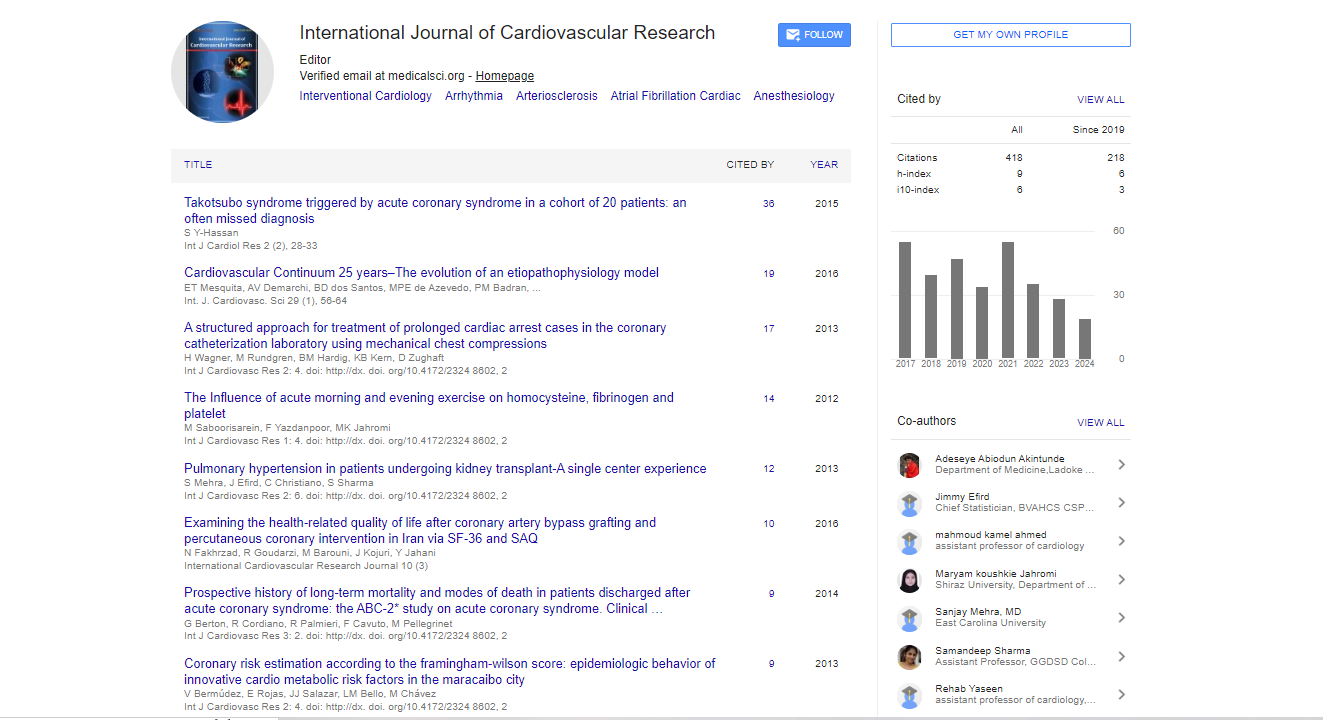Opinion Article, Int J Cardiol Res Vol: 13 Issue: 3
Atrioventricular Block: Mechanisms, Classification and Clinical Implications
Yuri Tanjiro*
1Department of Pharmacology, Toho University, Tokyo, Japan
*Corresponding Author: Yuri Tanjiro,
Department of Pharmacology, Toho
University, Tokyo, Japan
E-mail: tanjiro.yuri@med.toho-u.ac.jp
Received date: 27 May, 2024, Manuscript No. ICRJ-24-144344;
Editor assigned date: 30 May, 2024, PreQC No. ICRJ-24-144344 (PQ);
Reviewed date: 13 June, 2024, QC No. ICRJ-24-144344;
Revised date: 21 June, 2024, Manuscript No. ICRJ-24-144344 (R);
Published date: 28 June, 2024, DOI: 10.4172/2324-8602.1000563
Citation: Tanjiro (2Y024) Atrioventricular Block: Mechanisms, Classification and Clinical Implications. Int J Cardiol Res 13:3.
Description
Atrioventricular (AV) block is a significant cardiac conduction disorder characterized by a disruption in the electrical signals that coordinate the atria and ventricles. This condition can manifest in various forms, each with distinct pathophysiological mechanisms and clinical implications. Understanding AV block’s classification, causes and consequences is important for effective diagnosis and management, offering insights into the intricate dynamics of cardiac conduction and its impact on heart function. The heart’s electrical conduction system ensures synchronized contraction of the atria and ventricles, which is essential for efficient blood pumping. The AV node, situated at the junction between the atria and ventricles, plays a important role in this process by delaying the electrical impulse to allow adequate ventricular filling before contraction. AV block occurs when this conduction pathway is impaired, leading to a disruption in the normal rhythm and sequence of heartbeats.
First degree AV block is characterized by a prolonged PR interval on the Electrocardiogram (ECG), reflecting delayed conduction through the AV node. Despite the delay, each atrial impulse is successfully transmitted to the ventricles. First-degree AV block is often asymptomatic and benign, though it may indicate underlying heart disease or electrolyte imbalances. Second degree AV block is further divided into two subtypes. In Type I form, there is a progressive lengthening of the PR interval until a beat is dropped. The cycle then repeats. Type I AV block is often related to reversible conditions such as increased vagal tone or certain medications. Type II is characterized by intermittent failure of the AV node to conduct impulses to the ventricles, without a preceding lengthening of the PR interval. Type II AV block is more likely to progress to complete heart block and is associated with a higher risk of symptomatic bradycardia and other complications.
In third degree AV block, there is a complete dissociation between atrial and ventricular contractions. The atria and ventricles beat independently due to the failure of all impulses from the atria to reach the ventricles. This results in a significantly reduced heart rate and may lead to symptoms such as dizziness, syncope, or heart failure. Third degree AV block typically requires intervention with a pacemaker.
Causes of AV block
AV block can result from a variety of etiological factors. Conditions such as myocardial infarction, cardiomyopathy and valvular heart disease can disrupt the conduction system and lead to AV block. Fibrosis or ischemia of the AV node due to these conditions is a common underlying cause. Some individuals are born with congenital defects affecting the AV node or surrounding conduction pathways. These defects can manifest as AV block early in life and may require lifelong management. Certain drugs, particularly those affecting the autonomic nervous system or cardiac conduction, can induce AV block. Examples include beta-blockers, calcium channel blockers and digoxin. Viral infections, such as lyme disease and rheumatic fever, can cause inflammation of the AV node and result in AV block. Similarly, autoimmune disorders and systemic infections can impact the conduction system. Imbalances in electrolytes such as potassium and calcium can disrupt the electrical conduction system and lead to AV block. Conditions affecting metabolism, such as hypothyroidism, may also contribute to its development.
Conclusion
AV block encompasses a spectrum of conduction disturbances that impact the heart’s electrical system. Understanding the mechanisms, classifications and clinical implications of AV block is essential for accurate diagnosis and effective management. As study continues to advance, the development of improved diagnostic tools and therapeutic approaches will enhance our ability to address this complex condition, ultimately improving patient outcomes and quality of life. The interaction between the heart’s electrical conduction system and clinical manifestations of AV block tells about the importance of ongoing study and clinical observance in the management of this disorder.
 Spanish
Spanish  Chinese
Chinese  Russian
Russian  German
German  French
French  Japanese
Japanese  Portuguese
Portuguese  Hindi
Hindi 



